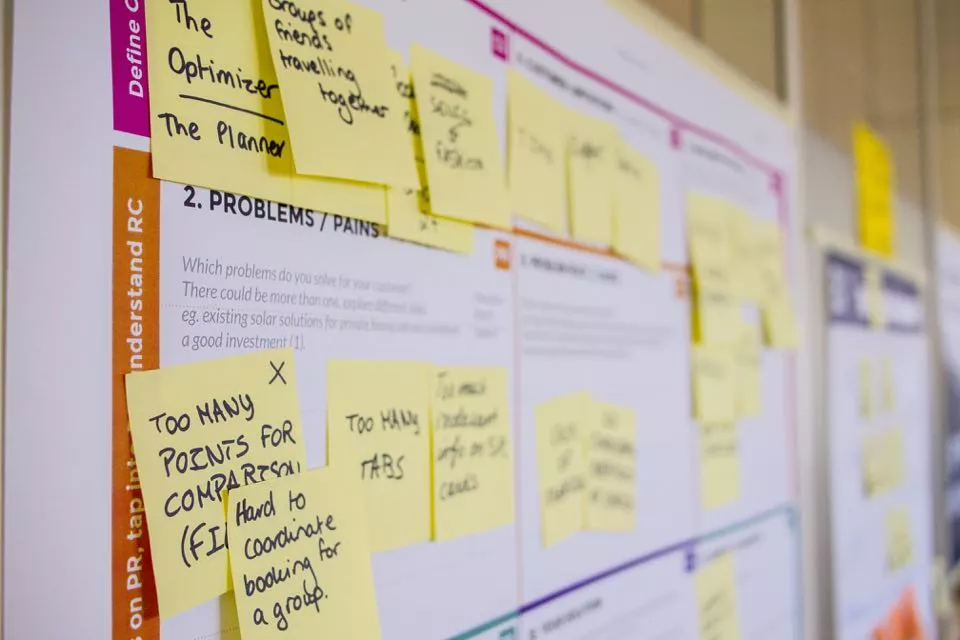
The Secret of Creativity in Business and Making Money
Creativity is most often associated with artists such as painters, fashion designers, pottery makers, or generally people who like to make things.
When “creativity” and “making money” are combined, someone usually thinks of artistic industries like selling artwork, advertising, selling artwork in museums, and possibly media or entertainment such as movies or television.
However, creativity or business creativity is not limited to any business, industry, or person. Creativity can be found in any business, organization, project, and even hobby. The more creative you get the more successful you're likely to be.
Business Creativity is About Solving Problems and Making Money - 15 minute read
- The Link Between Creativity And Making Money Is Problem Solving And Critical Thinking
- Changes Give Opportunities To New Entrepreneurs.
- 10 Ways Of Fostering Creativity In The Workplace
- Employing Creativity to Success…and More Money
- 6 Improvements for Businesses and Entrepreneurs to Have More Creativity
- There Is No Conclusion To Creativity And Making Money

The Link Between Creativity And Making Money Is Problem Solving And Critical Thinking
As an example, business creativity is like thinking of other ways to use math and arrive at the number 2. While most people would immediately say 1+1=2, creative problem solvers would be more thorough and answer 0+2, 4-2, 1*2, 2*1, 3-1, etc. to get to 2.
Creative problem solvers know that there is more than one way to get to an answer. Being creative actually allows you to solve problems in new or novel ways.
Creative thinking is one of the reasons why entrepreneurship is becoming so popular. With the number of gaps between problems and solutions in the world, entrepreneurs are seeing opportunities and can often move at a much faster rate, as they are more agile than big businesses to address these problems.
But it’s not just problems in business and in the world that entrepreneurs are trying to solve. As economies fluctuate, people lose jobs and some industries change or become obsolete.
The adage: “necessity is the mother of invention” is a well-known phrase that highlights the fact that people’s needs are a driving force for innovation.
☝🏽 back to top.
Changes Give Opportunities To New Entrepreneurs.
Entrepreneurs are those who think of creative ways to solve their own problem of how to make money despite the challenging times they are experiencing. They succeed by cultivating and using their business creativity.
Startup companies are able to raise money when investors see great potential for a given innovation or creative solution.
In fact, creative innovations are so important to investors that they have created an innovation index to find the next unicorn worth investing in.
But it’s not just entrepreneurs who are bringing in more money for themselves. Established businesses that put creativity and creative process in the forefront are often the biggest winners. Large companies like GAF saw a problem with asphalt waste. GAF gave the problem of waste a serious critical thought, they got creative, and ultimately turned trash to cash.
Pro Tip: Any time there is waste, it is the sign of an opportunity for someone to think critically about a situation, get creative about the solution, innovate, and hopefully make some money too.
☝🏽 back to top.

10 Ways Of Fostering Creativity In The Workplace
Hopefully you are beginning to understand that being more creative can be worth money.
So, how do you encourage creativity in yourself, in your teams, or in your organization? No matter the size of your organization, a culture of creativity with different perspectives should flourish in order to solve challenging problems in new ways.
What is important to remember is that creative thinking thrives in supportive environments where risk-taking and collaboration are encouraged.
Here are some guidelines to harness innovation and business creativity in your organization without spending any money:
1. Withhold Judgments
Noting inhibits creativity more than passing premature judgment on an idea. The one thing creative minds hate to hear is a “no” as soon as the idea comes out of their mouths.
Let people feel safe about voicing their ideas and opinions no matter how abstract, complicated, or irrelevant the solution may seem. Some innovations come from combining some ideas with other ideas and approaches.
Innovations such as the telephone were plagued with nay-sayers the first time it was placed on the market. Time proved that the innovators were right after all.
2. Set a Timetable
One of the pitfalls of creativity is that it can be an aimless, idea-generating machine that lacks focus, practicality, or at the worst, results.
A timetable helps your creative minds center their ideas around achieving a certain goal. Establish a timeline based on meaningful milestones and the results you need to achieve.
3. Keep Groups Small
There is a reason why startups and small businesses adapt better in radical business shifts like the recent pandemic—even with smaller budgets than large businesses.
Startup teams are small enough to plan and execute agile strategies. As they say, too many cooks spoil the broth.
The correct size team makes it easier to think critically about a problem, rigorously evaluate ideas, focus resources, and implement quickly.
4. Encourage Role-Playing
As with any creative endeavor, getting stuck on a problem can cause the whole creative process to stall.
One thing artists often use to free their mind is roleplaying, which works even in seemingly non-creative industries like banking or shopping.
The principle is simple. Sometimes, you’re stuck because you’re looking at things from your perspective. But what if you’re in the shoes of another person? If, instead of being the bank manager, you are suddenly the desperate customer who needs a loan?
Being in the shoes of another person gives you perspective about what you think can be done without the constraints of your current role.
5. Ask “What If” Questions
What-if musings are often the most important during risk assessments, especially when evaluating ideas.
Not all “what-if” ideas are negative because the ideas that come to mind can also be positive. One example is: “What if it’s too successful that we can’t handle the business coming in?”
When “what-if questions” highlight the risks in the idea, more creativity can be exercised, ensuring that the risk is mitigated and success can be achieved.
6. Encourage Diversity
Groupthink can sometimes be the enemy of creative innovations. Similar working styles, thought processes, views, and opinions can fail to see solutions that may be obvious to people different from the team.
Encourage teams to cross-ideate and even go out of the office to get information from an outsider’s point of view. Hire team members that are vastly different in perspectives and experience to see a shift in the ideation process instantaneously.
7. Provide Tools
At the end of the day, a creative team is limited by the tools they have on hand. From education to software and hardware requirements, the more tools the creative teams have at their disposal, the better chances of innovation happening. More importantly, tools need not be job-specific.
Sometimes, a stimulus or thought leader or organization are only things your creatives need to get going. Even something as seemingly mundane as changing the smell of the workspace can lead to greater productivity as Japanese researchers found out.
Often, organizing a problem and breaking it down into more specific concerns can help you see the issues more clearly and create creative solutions to the problems.
8. Don’t Penalize
In building a creative force in your business, you should be ready to eat failure for breakfast.
Failure is part of the business creativity process. When creatives are penalized for their failures, they have little to no motivation to try again…even if the next one might just be the perfect idea you need.
9. Create a Low-Stress Environment
Google is perhaps the best example of workplaces that reduce stress, fostering a high degree of creativity, thus making their company more money. But even without massive resources from Google, the simple act of encouraging communication, a positive attitude, and granting employees a bit more freedom can lower stress and increase their creative juices.
10 . Ask the Team to Look for Lots of Solutions, Not Just One
You will make more progress coming up with a novel solution to make money if you work through lots of ideas, rather than trying to laser-focus on considering one approach.
Focusing on finding one answer will overburden your mind. Remember that you need to free your imagination to pursue new approaches. Recommended Reading: X Ways to Improve your Creative Thinking to Make Money.
☝🏽 back to top.
Employing Creativity to Success…and More Money
The inability to harness creativity in the workforce in a deliberate manner can hold back the progress of a company and limit workforce engagement.
While some companies try to foster business creativity, they fail to do so because there is a gap in the creative process and the more stringent business processes. Many companies see their businesses as purely strategic, technical, and operational, not realizing how large a role creativity plays in innovation—a key to business growth and development.
Each job is not always the same, so creativity can be applied and used each time a problem or new situation arises among standardized processes.
At the same time, creative people often miss the importance of structured and technical aspects of making money. Artists who accept work on commissions (by hire) and want to earn money from their creations must not only think of doing great work, but they must also learn the basics of marketing and finance.
Insufficiently applying creativity while missing business aspects in creative pursuits can be bridged by applying design principles in a method called design thinking.
Design thinking, as the name implies, involves a lot of creativity and can be employed in the development of products and services, improving systems, procedures and protocols, and even creating better customer experiences.
In essence, design thinking creates value in innovation using customer-centric and user experience-centric approaches.
When it comes to innovation, design thinking is the bridge between creativity and business processes.
Organizations that employ design thinking are willing to continuously redesign the business to have constant advances in innovation and efficiency, bringing in a new competitive edge.
Even large companies are finding ways to get their large companies to employ creativity. Design-centric companies like Apple, Pepsi, Procter & Gamble and SAP outperformed the S&P 500 by 211% as they bring the “wow” factor when they bridge the gap of creativity and business.
Tesla is another prime example of creativity done right in business.
Just what is the creative side of Tesla that allows it to come up with new technologies that have consumers and clients lining up even before they launch?
According to Elon Musk, “I'm interested in things that change the world or that affect the future and wondrous, new technology where you see it, and you're like, 'Wow, how did that even happen? How is that possible?’”
Tesla saw the problems in the current automotive industry and used those problems to innovate and make it a cut above the rest.
As opposed to its competitors, Tesla did not just change the products, they changed the entire product ecosystem to make sure they succeeded.
In creating their vehicles, they also created new hardware and software architecture, investing in an entire set of complements that consumers need to be able to use Tesla cars, such as charging networks across the country.
But even if you don’t have the resources of Tesla, there are a number of ways you can use business creativity to make money.
Making a living in the gig economy by selling? You can livestream sales events or even do live online selling on video platforms like Facebook or TikTok.
Are you a yoga instructor? Online video classes can help you work those creative juices to make sure that your classes are engaging and fun to follow.
☝🏽 back to top.
6 Improvements for Businesses and Entrepreneurs to Have More Creativity
What changes will your company experience when you intentionally stitch creativity and creative processes into the very fabric of your company DNA?

1. Increased Agility and Adaptation
One of the biggest testaments to the importance of creativity in business is the COVID-19 pandemic and its impact in the economy.
Many businesses had gone out of business, while some survived, and it didn’t matter if the company was small or large—everyone was impacted.
What differentiates survivors from those that struggled the most or did not survive is their ability to think of creative ways for their businesses to generate revenue or lower expenses. That was how they ultimately survived despite trying times.
Be it technology enablement, a new process, or even a new product or service, creative companies have found ways to adapt and survive and adapt to make money even when everything seems bleak.
☝🏽 back to top.
2. Elevated Market Position
In a market with hundreds of thousands of companies competing for the same market space, differentiation and a competitive difference are essential.
Companies that look and feel like everyone else will get lost in the noise competing for consumer attention. Just like how the most creative ads stand out and get noticed, your company should employ the same creativity to be unique.
In bringing the creative aspect to all parts of the business, your company will have a competitive advantage that improves your market position.
☝🏽 back to top.
3. Increased Brand Value
At the end of the day, clients pay for their perceived value of your product or service. It doesn’t matter whether you’ve paid top dollar to make your product/service the best---if your clients and customers don’t see the value, they won’t buy your product.
Being creative helps you make a name and a statement in your industry. Bringing those innovations front and center in your marketing will build customer awareness and business creativity as they relate to the benefits of your offering.
When customers see how innovation benefits them, they will remember you.
☝🏽 back to top.
4. Better Customer Relationships
Design thinking puts the customer at the forefront of innovation. This means frequently talking to them and asking for their feedback to create solutions for the problems they experience.
The insights you receive can drive additional innovative ideas. New innovative ideas can entice current customers to purchase again, and also attract new customers.
☝🏽 back to top.
5. Boost Employee Engagement and Talent Acquisition
Companies lament the high turnover of millennial employees. One Gallup poll says that only 29% of millennials are engaged in the workplace; this means that turnover remains high for companies, costing millions of dollars in the process.
Business creativity can be used to create an innovative culture and engage millennials to explore their ideas and discover unique solutions.
Creativity also challenges the workforce and makes your team feel they are valued by the company.
When employees are engaged and happy, they have more reason to stay. Top talent would be more inclined to consider working in your company.
☝🏽 back to top.
6. Increase Efficiency and Cost Reductions
You can encourage business creativity at work by asking, “what if…?”. In asking “what if”, you can quickly see the risks, challenges and opportunities that are inherent in the innovation.
Instead of reacting to problems, you anticipate them happening and prepare for various outcomes.
This means reducing the panic that happens when something goes wrong, as well as the time lost in trying to think of haphazard solutions.
Your employees won’t sit idly waiting for orders wasting man-hours. Even if you have not planned for every situation, your creative-thinking employees are more than ready—and more importantly experienced—to help you with a solution of their own.
☝🏽 back to top.
There Is No Conclusion To Creativity And Making Money
As much as some would love to think that science, technology and economics are the most important factors to make money and create a thriving and growing business around, business creativity is critical and will always have a place in business and entrepreneurship.
Creativity is not just found in art galleries, craft projects, or in industries like marketing agencies. Creativity is in the fabric, DNA, processes, and personalities of individuals. You just might need to discover and unleash those talents from yourself or from within your company.
To neglect creativity is to neglect your team and the opportunity to grow and make more money with them.
The best companies in the world are changing the way they work by fostering more creativity in their businesses.
If they are willing to change their traditions and habits to be more creative, why shouldn’t you?
☝🏽 back to top.



